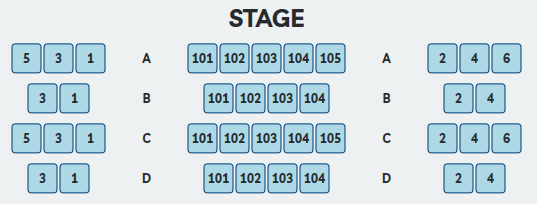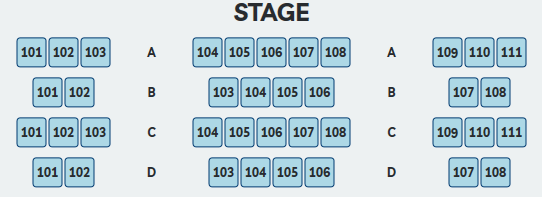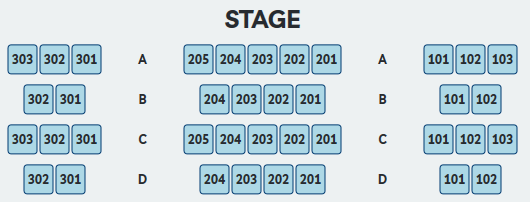Seat Numbering
Seat Number Schemes
There are currently three seat numbering schemes in addition to using manual numbering.
Odd-Sequential-Even Scheme
The Odd-Sequential-Even Scheme, commonly known as the New York or Broadway scheme, assumes the use of a combination of center and end aligned Row Reference lines. The scheme typically assumes three groups of rows, often separated by aisles, where the center grouping is sequential, and then the side groupings are either odd or even numbered in the same sequence.
Within this scheme, a user is able to decide the starting number for each of these groupings, and which end of the row (House Left or House Right) the numbering should begin. The settings also allow a user to decide which side of the room they want to be odd vs. even.
It is important to note that the relative position of the Focus Point is critical for this scheme to work. For the application to recognize that a group of End Aligned Row Reference lines are on the House Left side, the Focus Point needs to locate to the patron's right. In essence, the application is looking for the end of the Reference Line that is closest to the Focus Point in order to determine the Orientation within the room.

Sequential Scheme
The Sequential Scheme provides sequential numbering from one side of the room to the other, including center and end aligned rows. It does this by grouping Center, House Left End, and House Right End aligned rows, placing row identifiers on each, then numbering the sequence based on the row identifiers. This means that, if there is an additional starting row in one section (for instance, the center section has a Row A, but the side sections do not start until Row B), the numbering may get out of sync. As a result, it is important to select row groupings that are appropriately aligned, or work with each row or group of rows individually.
The sequential scheme can start from either the House Left side or the House Right side. The starting number may be preset.

Sequential Groups
The Sequential Groups is similar to the Odd-Sequential-Even Scheme, except that each group of Center, House Left End, and House Right End aligned rows are numbered sequentially (vs. the ends being odd or even.) Each of Center, House Left, and House Right may begin numbering on either the House Left or House Right end of the row, and each may have their own starting seat number.

Manual Numbering
Manual numbering allows a user to choose a manually entered starting number, and whether the seats should be numbered odd, even, or sequentially. This is selected in the Performance Seating Properties panel. The Settings window allows a user to set a default manual starting number for sequential, odd, and even numbering, as well as which side of the room the numbering should begin.
A user is able to select between their selected primary scheme and the manual scheme from within the Performance Seating Properties panel. However, a change to the primary scheme must be made in the Settings window.
Seat Number Schedules
Like Row Identifiers, seat numbers are stored in each seat family instance in the shared parameter PB_Seat_Number. These parameters may be used to schedule seating data in Furniture or Multi-Category schedules. Parameters may also be used to tag individual seats on plan and section documentation. Seat numbers are also displayed on the seats based on visibility.
Editing a Seat Number
(Future Feature)
A seat number may be edited by selecting a seat in that row, then editing it through the Performance Seating property window. Changing the seat number may trigger the following action items:
- The application will ask if additional seats associated with the same Row Reference Line should be renumbered.
- If there is another seat number with the same row designation in the same section, the application will ask if those seats should also be renumbered to avoid duplication.